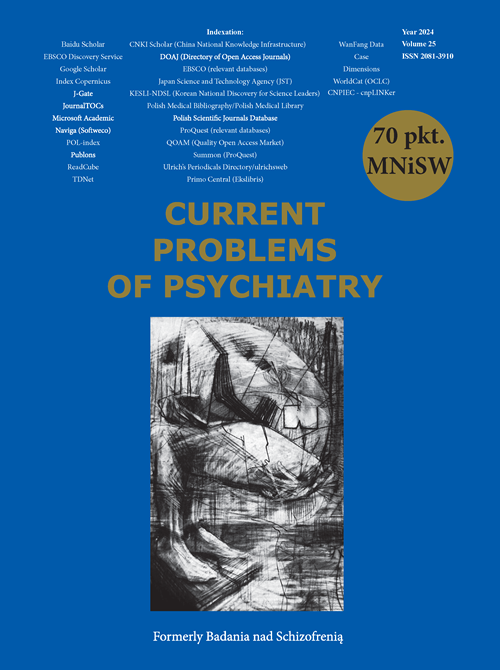The comparison of novel serious games in ADHD screening and early diagnosis
DOI:
https://doi.org/10.12923/2353-8627/2024-0019Słowa kluczowe:
zespół nadpobudliwości psychoruchowej z deficytem uwagi, gry użytkowe, gry wideo, diagnoza, badania przesiewoweAbstrakt
Wstęp: Pomimo rosnącej globalnej częstości występowania ADHD u dzieci, badania koncentrują się głównie na leczeniu, a nie na badaniach przesiewowych. Istnieje pilna potrzeba opracowania skutecznych narzędzi ułatwiających identyfikację tego zaburzenia. Celem niniejszego przeglądu było przeprowadzenie szczegółowej analizy nowych gier wykorzystywanych do badań przesiewowych i wczesnej diagnozy ADHD.
Materiał i metody: Nasze zainteresowanie koncentrowało się na porównaniu różnych aspektów, takich jak skuteczność, rodzaje testowanych parametrów, charakterystyka grupy badawczej, czasochłonność i rodzaj sprzętu niezbędnego do przeprowadzenia gry. Źródła zostały zebrane poprzez wyszukiwanie terminów związanych z badaniami przesiewowymi i diagnozą ADHD w kontekście gier za pośrednictwem kilku baz danych. Kryteria włączenia koncentrowały się na artykułach z lat 2020-2024, w języku angielskim i ogólnodostępnych. Dziesięć badań klinicznych spełniających kryteria zostało zidentyfikowanych, przeanalizowanych i porównanych w kolejnych sekcjach.
Dyskusja: Nasza analiza wykazała, że omawiane gry charakteryzują się odmienną mechaniką i mierzą różne parametry związane z ADHD. Metody ich walidacji nie są ustandaryzowane. Aspekty te utrudniają ich porównanie. Niektóre gry wykorzystują zaawansowane technologie w celu zwiększenia obiektywności procesu badań przesiewowych.
Wnioski: Wyniki naszego przeglądu potwierdzają, że porównywalną skuteczność badań przesiewowych do tej uzyskanej za pomocą standardowych testów można uzyskać za pomocą gier użytkowych. Osoby z ADHD są bardziej narażone na uzależnienie, choć dostosowane gry wideo mogą pomóc w leczeniu ADHD. Istnieje jednak potrzeba standaryzacji metodologii oceny skuteczności analizowanych gier.
Bibliografia
1. Posner J, Polanczyk GV, Sonuga-Barke E. Attentiondeficit hyperactivity disorder. The Lancet. 2020 February;39510222:450–62. https://doi.org/10.1016/S0140-6736(19)33004-1
2. Drechsler R, Brem S, Brandeis D, Grünblatt E, Berger G, Walitza S. ADHD: Current Concepts and Treatments in Children and Adolescents. Neuropediatrics. 2020 October;515:315–35. PMID: 32559806. https://doi.org/10.1055/s-0040-1701658
3. Teruel MA, Sanchis J, Ruiz-Robledillo N, Albaladejo-Blázquez N, Ferrer-Cascales R, Trujillo J. Measuring attention of ADHD patients by means of a computer game featuring biometrical data gathering. Heliyon. 2024 March 15;105:e26555. https://doi.org/10.1016/j.heliyon.2024.e26555
4. Sujar A, Bayona S, Delgado-Gómez D, et al. Attention Deficit Hyperactivity Disorder Assessment Based on Patient Behavior Exhibited in a Car Video Game: A Pilot Study. Brain Sci. 2022 July;127:877. https://doi.org/10.3390/brainsci12070877
5. Lee W, Lee D, Lee S, Jun K, Kim MS. Deep-Learning-Based ADHD Classification Using Children’s Skeleton Data Acquired through the ADHD Screening Game. Sensors. 2023 January;231:246. https://doi.org/10.3390/s23010246
6. Delgado-Gómez D, Sújar A, Ardoy-Cuadros J, et al. Objective Assessment of Attention-Deficit Hyperactivity Disorder (ADHD) Using an Infinite Runner-Based Computer Game: A Pilot Study. Brain Sci. 2020 October 9;1010:716. https://doi.org/10.3390/brainsci10100716.
7. Pandria N, Petronikolou V, Lazaridis A, et al. Information System for Symptom Diagnosis and Improvement of Attention Deficit Hyperactivity Disorder: Protocol for a Nonrandomized Controlled Pilot Study. JMIR Res Protoc. 2022 September 28;119:e40189. https://doi.org/10.2196/40189
8. Kazda L, Bell K, Thomas R, McGeechan K, Sims R, Barratt A. Overdiagnosis of Attention-Deficit/Hyperactivity Disorder in Children and Adolescents. JAMA Netw Open. 2021 April 12;44:e215335. PMID: 33843998. https://doi.org/10.1001/jamanetworkopen.2021.5335.
9. ADHD in children and young people: prevalence, care pathways, and service provision - ClinicalKey n.d. https://www.clinicalkey.com/#!/content/playContent/1-s2.0-S2215036617301670?scrollTo=%23hl0000909 (accessed May 18, 2024).
10. Faraone SV, Banaschewski T, Coghill D, et al. The World Federation of ADHD International Consensus Statement: 208 Evidence-based conclusions about the disorder. Neurosci Biobehav Rev. 2021 September;128:789–818. https://doi.org/10.1016/j.neubiorev.2021.01.022
11. Serrano-Barroso A, Siugzdaite R, Guerrero-Cubero J, et al. Detecting Attention Levels in ADHD Children with a Video Game and the Measurement of Brain Activity with a Single-Channel BCI Headset. Sensors. 2021 January;219:3221. https://doi.org/10.3390/s21093221.
12. Merzon L, Pettersson K, Aronen ET, et al. Eye movement behavior in a real-world virtual reality task reveals ADHD in children. Sci Rep. 2022 November 24;121:20308. https://doi.org/10.1038/s41598-022-24552-4
13. Kovess-Masfety V, Yan G, Yin H, et al. Chinese version of Dominic Interactive – A self-report video game for assessing mental health in young children. Front Psychiatry. 2023 April 24;14. https://doi.org/10.3389/fpsyt.2023.1149970
14. Schwarz AF, Huertas-Delgado FJ, Cardon G, DeSmet A. Design Features Associated with User Engagement in Digital Games for Healthy Lifestyle Promotion in Youth: A Systematic Review of Qualitative and Quantitative Studies. Games Health J. 2020 June 1;93:150–63. https://doi.org/10.1089/g4h.2019.0058
15. Sempere-Tortosa M, Fernández-Carrasco F, Navarro-Soria I, Rizo-Maestre C. Movement Patterns in Students Diagnosed with ADHD, Objective Measurement in a Natural Learning Environment. Int J Environ Res Public Health. 2021 April 7;188:3870. https://doi.org/10.3390/ijerph18083870
16. Lee D-W, Lee S, Ahn DH, Lee GH, Jun K, Kim MS. Development of a Multiple RGB-D Sensor System for ADHD Screening and Improvement of Classification Performance Using Feature Selection Method. Appl Sci. 2023 February 22;135:2798. https://doi.org/10.3390/app13052798
17. Sújar A, Martín-Moratinos M, Rodrigo-Yanguas M, et al. Developing Serious Video Games to Treat Attention Deficit Hyperactivity Disorder: Tutorial Guide. JMIR Serious Games. 2022 August 1;103:e33884. PMID: 35916694. https://doi.org/10.2196/33884
18. Koncz P, Demetrovics Z, Takacs ZK, Griffiths MD, Nagy T, Király O. The emerging evidence on the association between symptoms of ADHD and gaming disorder: A systematic review and metaanalysis. Clin Psychol Rev. 2023 December;106:102343. PMID: 37883910. https://doi.org/10.1016/j.cpr.2023.102343
19. Masi L, Abadie P, Herba C, Emond M, Gingras M-P, Amor LB. Video Games in ADHD and Non-ADHD Children: Modalities of Use and Association With ADHD Symptoms. Front Pediatr. 2021;9:632272. PMID: 33777866. https://doi.org/10.3389/fped.2021.632272.
20. Rodrigo-Yanguas M, González-Tardón C, Bella-Fernández M, Blasco-Fontecilla H. Serious Video Games: Angels or Demons in Patients With Attention-Deficit Hyperactivity Disorder? A Quasi-Systematic Review. Front Psychiatry. 2022;13:798480. PMID: 35573357. https://doi.org/10.3389/fpsyt.2022.798480
21. Wiguna T, Wigantara NA, Ismail RI, et al. A Four-Step Method for the Development of an ADHD-VR Digital Game Diagnostic Tool Prototype for Children Using a DL Model. Front Psychiatry. 2020;11:829. PMID: 32973578. https://doi.org/10.3389/fpsyt.2020.00829
22. Ou Y-K, Wang Y, Chang H-C, Yen S-Y, Zheng Y-H, Lee B-O. Development of virtual reality rehabilitation games for children with attention-deficit hyperactivity disorder. J Ambient Intell Humaniz Comput. 2020 November 1;11. https://doi.org/10.1007/s12652-020-01945-9
23. Martin-Moratinos M, Bella-Fernández M, Blasco-Fontecilla H. Effects of Music on Attention-Deficit/Hyperactivity Disorder (ADHD) and Potential Application in Serious Video Games: Systematic Review. J Med Internet Res. 2023 May 12;25:e37742. PMID: 37171837. https://doi.org/10.2196/37742
24. Mulraney M, Arrondo G, Musullulu H, et al. Systematic Review and Meta-analysis: Screening Tools for Attention-Deficit/Hyperactivity Disorder in Children and Adolescents. J Am Acad Child Adolesc Psychiatry. 2022 August;618:982–96. PMID: 34958872. https://doi.org/10.1016/j.jaac.2021.11.031
25. Emser TS, Johnston BA, Steele JD, Kooij S, Thorell L, Christiansen H. Assessing ADHD symptoms in children and adults: evaluating the role of objective measures. Behav Brain Funct BBF. 2018 May 18;141:11. PMID: 29776429. https://doi.org/10.1186/s12993-018-0143-x
Pobrania
Opublikowane
Numer
Dział
Licencja
Prawa autorskie (c) 2024 Autorzy

Utwór dostępny jest na licencji Creative Commons Uznanie autorstwa 4.0 Międzynarodowe.


